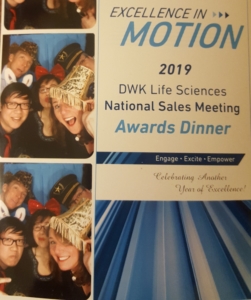John traveled to Sedona to work with a customer at their national sales kickoff meeting. On one of his many hikes, he came across Robert, the flute player. Listen in on this soothing two minute escape for a break in your busy day.
Archive for month: February, 2019

We just concluded the fourth of four SKO meetings with our customers over a five-week period, and we ready for a nap. The cities included Sedona, AZ, Tampa, FL, Cleveland (Aurora), OH and Kingsport, TN. How much knowledge, excitement, reflection, presentations, awards, conversation, redundancy, partying and planning can be packed into a 3- or 4-day session? Well, it turns out that A LOT is the answer.
There was your regular run of the mill events at each of the four, but also tremendous highlights as it pertains to new team members, capital infusions, product launches and laser like focus on customers and emerging markets. Our part was to contribute to the continual learning for the Sales teams, and other individuals in customer facing roles. While all companies embraced their own “theme” for the meeting, we intertwined and reinforced the fundamentals on the tactical execution of sales success as it relates to our customers’ commercial strategy.
Many of our competitors are working on the next, new shiny object in selling; not us. In the sales training business, some are looking to offer the silver bullet, or latest trend on what can appear to be a fashion industry-like approach. The leaders of the companies we work for are focused on executing the basics well, then taking it to the next level. But we have to get the fundamentals right, and we help them to do that in all skill set capacities.
To the teams we recently trained: now that you’ve let all that information you received at your SKO settle in, and got back into your regular routine, pick up your Sales Tool Kit, review the on-line modules of your sales process and get ready to have better conversations with customers and prospects. And Managers, it is your job to make sure your sellers are improving their selling skills, one opportunity at a time. Let’s get going!
Too many salespeople show up with an attitude. It sounds like this. “I’ve got the best solution available, and my job is to convince my prospects that I’m right. This is the “try harder” syndrome. This attitude just doesn’t work well any longer. Here’s a list of the beliefs that salespeople have that will do them more harm than good and what you should be believing instead.
Faulty Belief: I need to educate my prospect; presentation skills are my most effective tool.
Winning Belief: Your job is to qualify your prospect and investigative skills are your most effective tool. Let’s face it, no one ever lost a sale by listening too much.
Faulty Belief: Everyone needs what I sell; hearing “no” is a failure.
Winning Belief: A more productive belief is that not everyone is a prospect for
what I sell and “no” is not a failure as long as I’ve qualified the opportunity adequately.
Faulty Belief: When the prospect says, “I need to think it over,” there’s still a chance.
Winning Belief: You should be skeptical (not reassured) when your prospect tells you that he needs to “think it over.”
Faulty Belief: My features and benefits differentiate me from my competitors; they give me an advantage.
Winning Belief: If you rely on features and benefits, you’re probably going to sound just like everybody else, and your prospect may conclude that what you sell is just a commodity. When you’re perceived as a commodity, price becomes the most important buying criteria.
Faulty Belief: My job is to convince my prospect that he would benefit from purchasing from me; I need to be a good closer.
Winning Belief: It’s the prospect’s job to convince you that he has a problem, the budget and the decision-making ability to fix it and needs your help. Try this attitude on your next sales interview and see how it will change your approach.
Faulty Belief: Financial considerations are the most important factor in determining who gets the business.
Winning Belief: If you can help them increase their business or save them money, your price is relative to their gain.
Faulty Belief: If my prospects like me, they will buy from me.
Winning Belief: The real issue is whether or not the prospect thinks you can solve their problem. If they do, you’re likely to get the business.
Key Points
1. Your attitudes and beliefs are very important; they dictate what you do and how you do it. Ultimately, your attitudes and beliefs control your results.
2. Hearing “no” is not a failure; not everyone is a prospect for your product or service.
3. You should believe in the Law of Abundance – there’s plenty of business out there. Don’t hang on to a prospective client when the odds of being successful are slim. Find another opportunity.
We’ve all experienced a lot of technology-driven change in our lives. Just how much change depends on how old you are. People in their 50s can remember a time before the Internet. People in their 30s can remember life before Uber. And twenty-somethings just might remember when their parents carried flip phones, not iPhones.
If it seems like technology only evolves faster and faster, that’s not your imagination. It’s true—meaning we can expect more disruption and change in the near future, even in the field of sales. But when you work in sales, you have to make sure you’re looking at those changes through the right lens. There’s how technology has changed sales, and then there’s how technology has changed how we sell.
How Technology Has Changed How We Sell
Technology will keep changing sales. Vendors will develop new apps we can’t even imagine yet. Software will automate sales processes. Artificial Intelligence will score leads. Chatbots will handle online queries…and so on. All of us in sales will be on a constant learning curve to keep up. But if we’re not also thinking through how we must change our approach to sales, that tech might not do us all that much good. So here’s a look at three ways technology has changed how we sell—and how we must adapt…
- Buyers go looking for information on their own.
These days, when buyers have a need, they go looking for answers on their own—and they’re not calling a sales rep to get those answers. According to Forrester:
- 68% of prospects prefer to research on their own online
- 60% prefer not to interact with a sales rep as their primary source of information
- 62% say they can develop selection criteria or finalize a vendor list based on digital content
What does this mean for you and how you approach sales? You need to understand where the buyer is in the sales journey, and you need to be ready to offer them help and content appropriate to where they are in the process.
- The channels we use have changed.
Millennials do not like to use the phone. OK, they like to use their mobile phones, but not for phone calls. They use their mobile devices as communications tools, but for them that means texting, messaging and emailing.
What does this mean for you and how you approach sales? You need to know more about your prospect so your efforts are targeted, and you need to know how your prospect wants to be approached. Is email better than a phone call? What about a LinkedIn message? Do you have a mutual connection who can make an introduction?
- Social media is commonplace.
Salespeople used to build relationships in real life. Now we build them online as part of “social selling.” We network on platforms like LinkedIn and Twitter and build relationships that way. In addition, customers are also turning to social media when they’re researching possible solutions to their problems—and the vendors that sell them.
What does this mean for you and how you approach sales? You need to be where your customers are. Research shows that salespeople who use social media outperform their competitors. Get active on the social platforms used by your prospects and build a presence—and relationships—there.
Technology will continue to transform how we live our lives, both personally and professionally. The upside is, we have more time to sell when processes can be automated and data drives our sales efforts. So let’s take that extra time we’re getting back to make sure our approach to sales is keeping pace with the technology—and equal to our customers’ expectations of us.

Who
My name is Courtney and I have spent my 13-year career in Sales and Marketing. The majority of that time has been in the scientific lab supply space and the remainder has been building and optimizing digital marketing campaigns for small to medium sized businesses.
I earned a Bachelor of Science degree in Biology and Masters of Business Administration, both from VA Tech and think the two disciplines go together like hydrogen and oxygen.
What
Marketing with Science is a marketing consulting business I’ve started that brings the structured approach of science to the revenue problems that plague businesses.
Remember “The Scientific Method”? You start with a hypothesis (a statement that you want to test that is a solution for a problem). You test it, collect data, analyze it and either adjust your hypothesis or solve your problem.
I focus on two main areas to create hypotheses and test them:
[1] Target Marketing
- CLIENT 360 ANALYSIS – Who is your client? Why did they hire you? What do they like? What can be better?
- BUYER PERSONAS – Who are your customers? What are their attributes, demographics and psychographics? Where do they hang out?
- CLIENT EXPERIENCE – Are your clients happy? Are they succeeding? Are they using all of your offerings? How might they rate you?
[2] Revenue Process Design
- YOUR USP – What is your unique selling proposition? What business are you in?
- MESSAGING – What do your prime prospects want to hear? What might motivate them?
- SALES STRATEGY – What does your sales effort look like? What should a sales person do?
Where
One could argue that this approach to solving revenue problems would not have been capable 15 years ago. The online space, digital marketing in particular, has provided insight into demographics and behavior unlike anything before.
There are different tools online (Social Media, CPC Ads, email, Content) that, when used correctly provide specific information to solve variables your business faces.
Why
There are a lot of variables that go into your business generating revenue. The more you can identify and define these variables, the better results you get with each go-to-market strategy.
Some examples of revenue-related variables: unique selling proposition, problem you solve, solution you offer, how you present your solution, who benefits from your solution, where they spend their time, target audience (demographics, geography, timing, title, decision maker etc.), etc.
When you need to increase sales, how confident are you in the levers you choose to pull?
When
Is there really a time when you can’t benefit from learning?
Whether you’re a new business and you don’t have any clients, or you’ve been around for 40 years and sales are maybe, shall we say, stagnant, even if you’re a business that’s established and revenue is rolling in — it’s worth it to understand why. What did you do (either now, in the past or not yet) that got people’s attention?
So if you have a business hypothesis you’d like to test or some variables you’d like to define to spend less, earn more or earn more…faster — let’s talk!
We are excited to be included in the San Diego Business Journal’s 2019 Book of Lists for Top Training Companies for 3 straight years.
If you would like to hear more on how to drive revenue for your business call John today for a conversation at 858-518-7039



